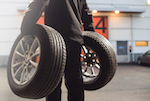September is definitely a month where we are not far from winter, as we are already in Autumn. During the end of autumn, winter conditions are likely to be seen, where it is unlikely in September, but likely in November. Even in October the temperatures can drop below zero degrees Celsius. When you have sub-zero temperatures, you are safer driving with winter tyres than summer tyres, which gives an indication that you should be prepared to change to winter tyres already when the temperatures start approaching zero degrees.
The problem with summer tyres at low temperatures is that the tyres are designed for warm temperatures and when you go to minus degrees the rubber will turn hard and it will not exhibit the same flexibility. When the tyres lose its flexibility, they will not be able to provide the necessary grip required for safe driving. On the other hand, winter tyres are able to remain soft and flexible at minus degrees, as they are designed for this. When you have hard tires even on dry surfaces you will have significantly reduced grip and when you have snow or ice, you basically have very little grip. In addition, the tread design for summer tyres is not aimed for snow or ice, it is produced for wet or dry roads.
For winter tyres you have either non-studded or studded tyres, which are both approved for winter use and are great on both snow and ice. The studded tyres do however have slightly better grip on icy surfaces, so if you need tyres that have the best grip on ice, then you will need studded tyres. One of the drawbacks with studded tyres, is that there are more restrictions related to them, if they are even allowed in your country. They tend to have regulations related to the time that they can be used and also where they can be used. Germany and Poland for example have banned their use, so you can’t not enter the border when you have studded tyres, which can cause some logistically issues.
One alternative for Central Europe is also using all-weather tyres that are winter approved. This way you get the benefits of having both winter and summer tyres in the same set of tyres. All-weather tyres do provide a good option for areas that have a bit more uncertain weather or also where you travel a lot between areas that have very varying weather. With all-weather tyres you are always ready to drive regardless of weather conditions and you are never caught with having tyres that could jeopardize your safety when you drive due to weather conditions.
If you do have real and long winters and still want some flexibility, you can always use non-studded tyres, that have no country or time restrictions for their use. They should however still be paired with summer tyres for the summer season and here you just need to make sure that you mount them before the winter season starts.
For more information regarding winter tyres, visit: https://www.nokiantyres.com/
